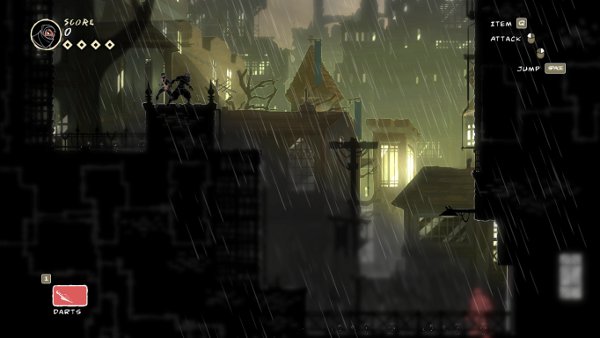Magnificent And Important Advent Calendar: Day Thirteen
Shhhhhhhhh
Keep quiet. He's sliding down the chimney and coming for us! But how did he get to the roof in the first place? Maybe he climbed up the drainpipe or sprinted across the terraces opposite and leapt through the darkness like a silent curse. Maybe he's not in the chimney at all. Maybe you left a window open, but it's on the third floor so you'll be safe, right? RIGHT? Oh cripes, the thirteenth window of the advent calendar is open. He's probably inside.
It's... Mark of the Ninja!
Adam:
Long version: Thief had the visibility gem, an indicator that faded to near-black when the player was in shadow, a means of communicating the safety of the player’s position, swiftly updating, without compromising the first-person perspective. Mark of the Ninja doesn’t have anything quite as simple but it’s a game in which the data of stealth are written on the world.
Anything that could potentially compromise the player’s infiltrations, rescues, robberies and assassinations has a visual tell – noise sends fading pulses into the night, an enemy’s line of sight is marked as a cone protruding from his face, and, like Thief’s gem, people are drained of colour when they step into darkness. Mark of the Ninja has been opened up, like that electric-nosed fellow in Operation, and its nervous system is on display. Tease the wrong element and *BZZZZZZ*.
I’d heard that the game was good before the PC port arrived but I wasn’t convinced. Stealth Bastard (not Deluxe) had already admirably tackled stealth in 2d, interpreting problems of sound and light as self-contained puzzles, but to create a side-scrolling stealth adventure is an entirely different proposition.
When I first played, the view was too close to the characters for my liking. I wanted to survey an area and plan my approach. Then, by the time I’d finished the tutorial, the system had started to make sense. At the end of the first mission I was fully converted.
Mark of the Ninja has the sort of levels that I’d like to see in full, paparazzi long-lens cross-sections of castles and skyscrapers, every room a story and all contributing to a structure with a sense of purpose. They’re the sort of places that magazines would have printed double-spread walkthroughs of when magazines still existed. The annotations couldn’t tell the reader how to succeed though because, beyond the elegance of the interface feedback and the level design, the game’s strongest feature is the variety of approaches that it offers.
The toolset isn’t large. By the end, which came too soon for my liking, you’ll have encountered a few types of enemies, several abilities and devices, and rooms with two or three entry points, corners and crannies. What you won’t be able to do is see everything on a single playthrough because there are choices to make not only in approach but in advancement. Do you want to drop deadly spike traps from a ceiling, or would you rather cloud a guard’s mind with hallucinogenic terror-drugs? Or perhaps travel through the entire game like a ghost, which is what I’m trying to do at the moment, on my second attempt.
There are very few places that punish mistakes with instant failure, although ninjas can’t dodge bullets, but I actually found myself trying to collect as many points as possible on each level. It’s so unlike the way I normally play and being offered carrots for playing a certain way should irritate me, but realising that an accidental killing (the chandelier support just snapped) can be slightly redeemed by dropping the corpse into a drainage pipe is a good thing. Receiving a little high five every time I ditch a body into a vent makes me a jollier ninja.
It’s one of the few games that I want to ‘100%’. I’ll remember that I used that as a verb tomorrow and groan but it’s appropriate even if it is ugly. For all its brilliant setpieces, large and small, Mark of the Ninja is a game first and an experience second. There are near-constant reminders in the visual feedback, the scoring system and the unlocks. ‘Seeing’ footsteps doesn’t need some bullshit NINJASENSES explanation – it’s empowerment and a sort of discourse with the player. That’s enough.
There is a story and it even has magical tattoos (this year’s genetic mutations) but I’m not playing a second time to explore the nuance of the characters. I just want to see how much better I am now that I know more tricks and I want to do everything that it’s possible for a ninja to do.
Short version: I threw a knife that sliced through a rope, dumping a chandelier on a man’s head, flattening him. One of his friends panicked, fell on his backside and started shooting in blind panic, killing everyone else in the room. Except for me. I was still in the rafters, watching and laughing (silently), the happiest ninja in the land.





